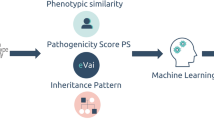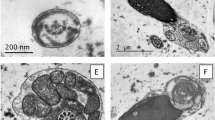Abstract
Purpose
Preimplantation genetic testing (PGT) has become a reliable tool for preventing the germline transmission of mitochondrial DNA (mtDNA) variants. However, procedures are not standardized across mtDNA variants. In this study, we aim to estimate symptomatic thresholds, risk, and chance of success for PGT for mtDNA pathogenic variant carriers.
Methods
We performed a systematic analysis of heteroplasmy data including 455 individuals from 187 familial pedigrees with the common m.3243A>G, m.8344A>G, or m.8993T>G pathogenic variants. We applied binary logistic regression for estimating symptomatic thresholds of heteroplasmy, simplified Sewell-Wright formula and Kimura equations for predicting the risk of disease transmission, and binomial distribution for predicting minimum oocyte numbers.
Results
We estimated the symptomatic thresholds of m.8993T>G and m.8344A>G as 29.86% and 16.15%, respectively. We could not determine a threshold for m.3243A>G. We established models for mothers harboring common and rare mtDNA pathogenic variants to predict the risk of disease transmission and the number of oocytes required to produce an embryo with sufficiently low variant load. In addition, we provide a table allowing the prediction of transmission risk and the minimum required oocytes for PGT patients with different variant levels.
Conclusion
We have established models that can determine the symptomatic thresholds of common mtDNA pathogenic variants. We also constructed universal models applicable to nearly all mtDNA pathogenic variants which can predict risk and minimum numbers for PGT patients. These models have advanced our understanding of mtDNA disease pathogenesis and will enable more effective prevention of disease transmission using PGT.




Similar content being viewed by others
Data availability
All relevant data are within the manuscript and the supplementary materials. All raw data is publicly available at Mendeley Data: Ji, Dongmei; Zhang, Ning; Zou, Weiwei; Zhang, Zhikang; Marley, Jordan; Liu, Zhuoli; Liang, Chunmei; Shen, Lingchao; Liu, Yajing; Liang, Dan; Su, Tianhong; Du, Yinan; Cao, Yunxia (2022), “Data of Modeling-based prediction tools for preimplantation genetic testing of mitochondrial DNA diseases,” Mendeley Data, V1, doi: 10.17632/ynx4mmhbxr.1 (https://data.mendeley.com/datasets/ynx4mmhbxr).
References
Gorman GS, Schaefer AM, Ng Y, Gomez N, Blakely EL, Alston CL, et al. Prevalence of nuclear and mitochondrial DNA mutations related to adult mitochondrial disease. Ann Neurol. 2015;77(5):753–9.
Elliott HR, Samuels DC, Eden JA, Relton CL, Chinnery PF. Pathogenic mitochondrial DNA mutations are common in the general population. Am J Hum Genet. 2008;83(2):254–60.
Gal A, Balicza P, Weaver D, Naghdi S, Joseph SK, Várnai P, et al. MSTO1 is a cytoplasmic pro-mitochondrial fusion protein, whose mutation induces myopathy and ataxia in humans. EMBO Mol Med. 2017;9(7):967–84.
Alston CL, Rocha MC, Lax NZ, Turnbull DM, Taylor RW. The genetics and pathology of mitochondrial disease. J Pathol. 2017;241(2):236–50.
Lake NJ, Compton AG, Rahman S, Thorburn DR. Leigh syndrome: one disorder, more than 75 monogenic causes. Ann Neurol. 2016;79(2):190–203.
Craven L, Tang M-X, Gorman GS, De Sutter P, Heindryckx B. Novel reproductive technologies to prevent mitochondrial disease. Hum Reprod Update. 2017;23(5):501–19.
Wilson IJ, Carling PJ, Alston CL, Floros VI, Pyle A, Hudson G, et al. Mitochondrial DNA sequence characteristics modulate the size of the genetic bottleneck. Hum Mol Genet. 2016;25(5):1031–41.
Jacobs LJAM, de Wert G, Geraedts JPM, de Coo IFM, Smeets HJM. The transmission of OXPHOS disease and methods to prevent this. Hum Reprod Update. 2006;12(2):119–36.
Floros VI, Pyle A, Dietmann S, Wei W, Tang WCW, Irie N, et al. Segregation of mitochondrial DNA heteroplasmy through a developmental genetic bottleneck in human embryos. Nat Cell Biol. 2018;20(2):144–51.
Sallevelt SCEH, Dreesen JCFM, Drüsedau M, Spierts S, Coonen E, van Tienen FHJ, et al. Preimplantation genetic diagnosis in mitochondrial DNA disorders: challenge and success. J Med Genet. 2013;50(2):125–32.
Stewart JB, Chinnery PF. The dynamics of mitochondrial DNA heteroplasmy: implications for human health and disease. Nat Rev Genet. 2015;16(9):530–42.
Sonney S, Leipzig J, Lott MT, Zhang S, Procaccio V, Wallace DC, et al. Predicting the pathogenicity of novel variants in mitochondrial tRNA with MitoTIP. PLoS Comput Biol. 2017;13(12):e1005867.
Preste R, Vitale O, Clima R, Gasparre G, Attimonelli M. HmtVar: a new resource for human mitochondrial variations and pathogenicity data. Nucleic Acids Res. 2019;47(D1):D1202–D10.
Rajasimha HK, Chinnery PF, Samuels DC. Selection against pathogenic mtDNA mutations in a stem cell population leads to the loss of the 3243A-->G mutation in blood. Am J Hum Genet. 2008;82(2):333–43.
Zhang H, Burr SP, Chinnery PF. The mitochondrial DNA genetic bottleneck: inheritance and beyond. Essays Biochem. 2018;62(3):225–34.
van den Ameele J, Li AYZ, Ma H, Chinnery PF. Mitochondrial heteroplasmy beyond the oocyte bottleneck. Semin Cell Dev Biol. 2020;97:156–66.
Chinnery PF, Howell N, Lightowlers RN, Turnbull DM. Molecular pathology of MELAS and MERRF. The relationship between mutation load and clinical phenotypes. Brain. 1997;120(Pt 10):1713–21.
Rahman S, Poulton J, Marchington D, Suomalainen A. Decrease of 3243 A-->G mtDNA mutation from blood in MELAS syndrome: a longitudinal study. Am J Hum Genet. 2001;68(1):238–40.
Johnston IG. Varied mechanisms and models for the varying mitochondrial bottleneck. Front Cell Dev Biol. 2019;7:294.
Wonnapinij P, Chinnery PF, Samuels DC. The distribution of mitochondrial DNA heteroplasmy due to random genetic drift. Am J Hum Genet. 2008;83(5):582–93.
Wonnapinij P, Chinnery PF, Samuels DC. Previous estimates of mitochondrial DNA mutation level variance did not account for sampling error: comparing the mtDNA genetic bottleneck in mice and humans. Am J Hum Genet. 2010;86(4):540–50.
Brown DT, Samuels DC, Michael EM, Turnbull DM, Chinnery PF. Random genetic drift determines the level of mutant mtDNA in human primary oocytes. Am J Hum Genet. 2001;68(2):533–6.
Hellebrekers DMEI, Wolfe R, Hendrickx ATM, de Coo IFM, de Die CE, Geraedts JPM, et al. PGD and heteroplasmic mitochondrial DNA point mutations: a systematic review estimating the chance of healthy offspring. Hum Reprod Update. 2012;18(4):341–9.
Samuels DC, Wonnapinij P, Chinnery PF. Preventing the transmission of pathogenic mitochondrial DNA mutations: can we achieve long-term benefits from germ-line gene transfer? Hum Reprod. 2013;28(3):554–9.
Smeets HJM, Sallevelt SCEH, Dreesen JCFM, de Die-Smulders CEM, de Coo IFM. Preventing the transmission of mitochondrial DNA disorders using prenatal or preimplantation genetic diagnosis. Ann N Y Acad Sci. 2015;1350:29–36.
Dahl HH, Thorburn DR, White SL. Towards reliable prenatal diagnosis of mtDNA point mutations: studies of nt8993 mutations in oocytes, fetal tissues, children and adults. Hum Reprod. 2000;15(Suppl 2):246–55.
White SL, Collins VR, Wolfe R, Cleary MA, Shanske S, DiMauro S, et al. Genetic counseling and prenatal diagnosis for the mitochondrial DNA mutations at nucleotide 8993. Am J Hum Genet. 1999;65(2):474–82.
van de Glind G, de Vries M, Rodenburg R, Hol F, Smeitink J, Morava E. Resting muscle pain as the first clinical symptom in children carrying the MTTK A8344G mutation. Eur J Paediatr Neurol. 2007;11(4):243–6.
Li D, Liang C, Zhang T, Marley JL, Zou W, Lian M, et al. Pathogenic mitochondrial DNA 3243A>G mutation: from genetics to phenotype. Front Genet. 2022;13:951185.
Poulton J, Finsterer J, Yu-Wai-Man P. Genetic counselling for maternally inherited mitochondrial disorders. Mol Diagn Ther. 2017;21(4):419–29.
Damian MS, Seibel P, Schachenmayr W, Reichmann H, Dorndorf W. VACTERL with the mitochondrial np 3243 point mutation. Am J Med Genet. 1996 Apr 24;62(4):398–403.
Hammans SR, Sweeney MG, Hanna MG, Brockington M, Morgan-Hughes JA, Harding AE. The mitochondrial DNA transfer RNALeu(UUR) A-->G(3243) mutation. A clinical and genetic study. Brain. 1995;118(Pt 3):721–34.
Olsson C, Zethelius B, Lagerström-Fermér M, Asplund J, Berne C, Landegren U. Level of heteroplasmy for the mitochondrial mutation A3243G correlates with age at onset of diabetes and deafness. Hum Mutat. 1998;12(1):52–8.
Ciafaloni E, Ricci E, Shanske S, Moraes CT, Silvestri G, Hirano M, et al. MELAS: clinical features, biochemistry, and molecular genetics. Ann Neurol. 1992;31(4):391–8.
Pickett SJ, Blain A, Ng YS, Wilson IJ, Taylor RW, McFarland R, et al. Mitochondrial donation - which women could benefit? N Engl J Med. 2019;380(20):1971–2.
Monnot S, Gigarel N, Samuels DC, Burlet P, Hesters L, Frydman N, et al. Segregation of mtDNA throughout human embryofetal development: m.3243A>G as a model system. Hum Mutat. 2011;32(1):116–25.
Otten ABC, Sallevelt SCEH, Carling PJ, Dreesen JCFM, Drüsedau M, Spierts S, et al. Mutation-specific effects in germline transmission of pathogenic mtDNA variants. Hum Reprod. 2018;33(7):1331–41.
Dyer C. UK is set to allow mitochondrial donation after MPs vote in favour. BMJ. 2015;350:h657.
Dziadek MA, Sue CM. Mitochondrial donation: is Australia ready? Med J Aust. 2022;216(3):118–21.
Wise J. First baby born in the UK using mitochondrial donation therapy. BMJ. 2023;381:1091.
Gorman GS, McFarland R, Stewart J, Feeney C, Turnbull DM. Mitochondrial donation: from test tube to clinic. Lancet. 2018;392(10154):1191–2.
Acknowledgements
The authors thank Yuzhou Gao, Haoyu He, Yang Yang, Yuechen Wang, Pei Hong, Chongwu Xu, and Xuefeng Tian for collecting the data and helpful discussion.
Funding
The National Natural Science Foundation of China (Grant No: U20A20350 to Y.C., Grant No: 81971455 to D.J., Grant No: 82202043 to T.S., Grant No: 81871216 to Y.C., and Grant No: 31701162 to Y.D.), the National Key Research and Development Program of China (Grant No: 2021YFC2700901 to Y.D., D.J., W.Z., and D.L.), Shanghai Science and Technology Innovation Action Plan-Shanghai Sailing Program funded by Science and Technology Commission of Shanghai Municipality (Grant No: 22YF1431600 to T.S.), and the National College Students’ Innovation and Entrepreneurship Training Program (Grant No: 202210366004 to D.J. and N.Z.). The funders had no role in study design, data collection and analysis, decision to publish, or preparation of the manuscript.
Author information
Authors and Affiliations
Contributions
Conceptualization, D.J., N.Z., and W.Z.; data curation, D.J., N.Z., W.Z., Z.Z, J.L.M., Z.L., and C.L.; formal analysis, D.J., N.Z., W.Z., Z.Z, J.L.M., Z.L., C.L., L.S., Y.L., and D.L.; funding acquisition, D.J., N.Z., T.S., Y.D., and Y.C.; investigation, D.J., N.Z., W.Z., Z.Z, J.L.M., Z.L., C.L., L.S., Y.L., and D.L.; methodology, D.J., N.Z., W.Z., T.S., Y.D., and Y.C.; project administration, T.S., Y.D., and Y.C.; resources, T.S., Y.D., and Y.C.; software, D.J., N.Z., and W.Z.; supervision, T.S., Y.D., and Y.C.; validation, D.J., N.Z., W.Z., T.S., Y.D., and Y.C.; visualization, D.J., N.Z., W.Z., L.S., Y.L., and D.L., writing—original draft, D.J., N.Z., and W.Z.; writing—review and editing, J.L.M., T.S., Y.D., and Y.C. All authors read and approved the final version of the manuscript.
Corresponding authors
Ethics declarations
Ethics approval
The study was approved by the Ethics Committee of the First Affiliated Hospital of Anhui Medical University (PJ2020-08-15).
Consent to participate
Informed consent was obtained from all individual participants included in the study.
Competing interests
The authors declare no competing interests.
Additional information
Publisher’s note
Springer Nature remains neutral with regard to jurisdictional claims in published maps and institutional affiliations.
Supplementary information
ESM 1
(PDF 1106 kb)
Rights and permissions
Springer Nature or its licensor (e.g. a society or other partner) holds exclusive rights to this article under a publishing agreement with the author(s) or other rightsholder(s); author self-archiving of the accepted manuscript version of this article is solely governed by the terms of such publishing agreement and applicable law.
About this article
Cite this article
Ji, D., Zhang, N., Zou, W. et al. Modeling-based prediction tools for preimplantation genetic testing of mitochondrial DNA diseases: estimating symptomatic thresholds, risk, and chance of success. J Assist Reprod Genet 40, 2185–2196 (2023). https://doi.org/10.1007/s10815-023-02880-2
Received:
Accepted:
Published:
Issue Date:
DOI: https://doi.org/10.1007/s10815-023-02880-2




